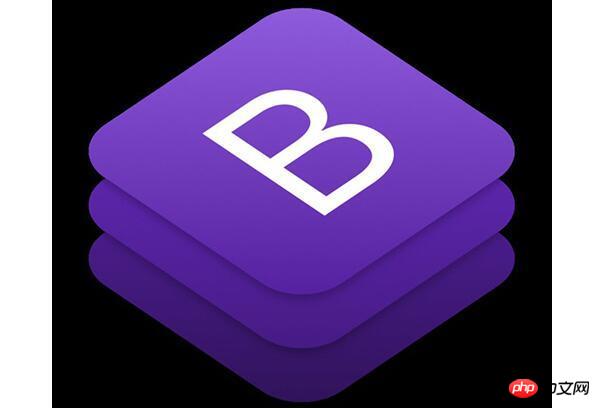css framework: summary of the five popular css frameworks
The content of this article is about CSS framework: a summary of the five popular CSS frameworks. It has certain reference value. Friends in need can refer to it. I hope it will be helpful to you.
Nowadays, CSS framework is becoming more and more popular, and it can be said that it has been applied to every website. As a development tool, CSS frameworks are always evolving and improving, so we strongly recommend that you pay attention to current trends. This article will take you through the 5 most popular CSS frameworks in 2017.
1. css framework: summary of the five popular css frameworks
This framework is one of GitHub’s star products and is considered to be the best responsive CSS framework. Designed specifically for front-end development, it helps build web design concepts, mobile-first projects, grid systems, typography, buttons, and more.

css framework: summary of the five popular css frameworks does not have any additional features, but there are third-party plugins available that feature other common UI elements in addition to regular HTML elements. Its core principles are RWD and mobile first. css framework: summary of the five popular css frameworks version 3 supports various browsers (the latest version), and starting with css framework: summary of the five popular css frameworks 2, the framework supports responsive web design. css framework: summary of the five popular css frameworks 4 version is currently under development.
css framework: summary of the five popular css frameworks is very popular, but it does not mean that it is better than other frameworks. Most people use it because of its popularity, and due to this, there are a lot of resources available (like tutorials, additional plugins, etc.) that make using css framework: summary of the five popular css frameworks easier.
2. css framework: summary of the five popular css frameworks
css framework: summary of the five popular css frameworks is an open source project and another giant in the CSS framework world. It is known to be very fluid and responsive and can be used for many purposes: building websites, creating email templates, building mobile and web applications.

#This framework is also very user-friendly, providing training, support, and consulting services. There are also some unique components (Keystrokes, Joyride, Flex Video, etc.) and some add-ons. In addition to RWD and mobile first, its core principles also include semantic.
css framework: summary of the five popular css frameworks has earned itself huge profits with a perfect workflow and great developer support. It is a very professional framework and provides a large number of tutorials available so that users can learn about css framework: summary of the five popular css frameworks at any time.
3. css framework: summary of the five popular css frameworks
css framework: summary of the five popular css frameworks is open source, free and saves developers time. It has become very popular recently because it is very simple to learn and use.

First of all, Bulma includes great UI components like tabs, navigation bars, boxes and panels, etc. as this framework is designed to provide users with clear and attractive Powerful UI. Secondly, Bulma is very modular and users can import only the required functions. Finally, the framework's classes are highly readable, which may be very attractive to some developers.
Bulma is easy to understand and use, and it has all the necessary features to help you create high-quality products efficiently.
4. css framework: summary of the five popular css frameworks
Maybe not many people know (use) this framework, but it has the same functionality as other similar frameworks.

css framework: summary of the five popular css frameworks is lightweight and modular for creating fast yet powerful web interfaces. css framework: summary of the five popular css frameworks is basically an easily customizable collection of components, featuring HTML Editor, Flex, other add-ons, and unique components. Its core principles are RWD and mobile first, css framework: summary of the five popular css frameworks is widely used in WordPress themes. Allows you to flexibly customize the mechanism manually.
5. Semantic UI
As you can guess from the name, Semantic UI aims to make the website building process more semantic. The core feature is to use natural language principles to make the code easier to read and understand.

The core principles are label contradiction, semantics, and responsiveness. This framework treats statements and classes as interchangeable components, using intuitive JS and easy debugging.
The good thing about Semantic UI is that it provides well-organized documentation and website with usage guides. In short, it has over 3000 theme variables, over 50 UI components, and over 5000 commits. Definitely worth a try. It’s a good choice for creating beautiful, responsive websites.
Related recommendations:
CSS framework BluePrint_html/css_WEB-ITnose
##CSS framework: Basscss_html/css_WEB-ITnose
The above is the detailed content of css framework: summary of the five popular css frameworks. For more information, please follow other related articles on the PHP Chinese website!

Hot AI Tools

Undresser.AI Undress
AI-powered app for creating realistic nude photos

AI Clothes Remover
Online AI tool for removing clothes from photos.

Undress AI Tool
Undress images for free

Clothoff.io
AI clothes remover

Video Face Swap
Swap faces in any video effortlessly with our completely free AI face swap tool!

Hot Article

Hot Tools

Notepad++7.3.1
Easy-to-use and free code editor

SublimeText3 Chinese version
Chinese version, very easy to use

Zend Studio 13.0.1
Powerful PHP integrated development environment

Dreamweaver CS6
Visual web development tools

SublimeText3 Mac version
God-level code editing software (SublimeText3)

Hot Topics
 1387
1387
 52
52
 What css framework does vue work with?
Dec 26, 2023 pm 01:48 PM
What css framework does vue work with?
Dec 26, 2023 pm 01:48 PM
There are four common CSS frameworks compatible with Vue: "BootstrapVue", "Element UI", "Vuetify", and "Buefy". The above frameworks are all open source and have huge community support. They provide rich UI components, flexible Layout options and easily customizable themes allow developers to quickly build beautiful, fully functional web applications.
 Recommend five excellent CSS frameworks to get twice the result with half the effort in front-end development
Jan 16, 2024 am 09:46 AM
Recommend five excellent CSS frameworks to get twice the result with half the effort in front-end development
Jan 16, 2024 am 09:46 AM
With the rapid development of the Internet, front-end development has become an important area that cannot be ignored. As front-end developers, we need to continuously improve our development efficiency and level. Using an excellent CSS framework is an effective way to improve front-end development efficiency. This article will introduce you to five excellent CSS frameworks, hoping to be helpful to your front-end development work. BootstrapBootstrap is one of the most popular CSS frameworks currently. It provides rich CSS classes and JavaScript
 What is the difference between css framework and component library
Dec 26, 2023 pm 05:03 PM
What is the difference between css framework and component library
Dec 26, 2023 pm 05:03 PM
CSS framework and component library are two different concepts, but there is a certain relationship between them: 1. CSS framework is a tool that provides a complete set of styles, layouts and components, while component library is for a specific A library for designing and developing components or modules; 2. The CSS framework is used to quickly build web pages and applications, and the component library provides a series of reusable UI components; 3. The framework usually contains a series of predefined CSS Classes and styles, while each component in the component library has independent styles and behaviors.
 What does css framework mean?
Oct 09, 2023 pm 05:56 PM
What does css framework mean?
Oct 09, 2023 pm 05:56 PM
A css framework is a library of pre-designed styles used to simplify and speed up the web development process. The CSS framework provides a set of defined CSS styles and layouts that developers can use directly to build web pages without having to write CSS code from scratch. CSS framework usually includes a series of commonly used web page components, such as buttons, tables, navigation bars, etc., as well as some common layout templates, such as grid system and responsive design, etc. Developers need to choose and use frameworks carefully to ensure web page performance and user experience.
 Explore the best responsive layout frameworks: the competition is fierce!
Feb 19, 2024 pm 05:19 PM
Explore the best responsive layout frameworks: the competition is fierce!
Feb 19, 2024 pm 05:19 PM
Responsive layout framework competition: who is the best choice? With the popularity and diversification of mobile devices, responsive layout of web pages has become more and more important. In order to cater to the different devices and screen sizes of users, it is essential to adopt a responsive layout framework when designing and developing web pages. However, with so many framework options out there, we can’t help but ask: which one is the best choice? The following will be a comparative evaluation of three popular responsive layout frameworks, namely Bootstrap, Foundation and Tailwind.
 What is the difference between CSS framework and component library?
Jan 16, 2024 am 08:56 AM
What is the difference between CSS framework and component library?
Jan 16, 2024 am 08:56 AM
What are the functional differences between CSS frameworks and component libraries? With the continuous development of web development, CSS frameworks and component libraries have become one of the commonly used tools among developers. Both can help developers build web interfaces more quickly and efficiently, but they have some differences in functionality. A CSS framework is a set of predefined style rules and layout templates designed to provide consistent and responsive design. They usually contain a series of CSS style files and style HTML elements through class and tag selectors. The role of CSS framework
 What are the css frameworks?
Oct 08, 2023 pm 01:31 PM
What are the css frameworks?
Oct 08, 2023 pm 01:31 PM
CSS frameworks include Bootstrap, Foundation, Bulma, Semantic UI and Materialize. Detailed introduction: 1. Bootstrap, which has various predefined styles and components such as easy-to-use grid systems, buttons, navigation bars, and form elements; 2. Foundation, which has components such as grid systems, buttons, navigation bars, etc., but it is more Focus on customization and scalability; 3. Bulma, with common components such as responsive grid system, buttons, form elements, etc.
 What are the front-end css frameworks?
Oct 08, 2023 am 11:45 AM
What are the front-end css frameworks?
Oct 08, 2023 am 11:45 AM
Front-end css frameworks include Bootstrap, Foundation, Semantic UI, Bulma and Material-UI. Detailed introduction: 1. Bootstrap, which provides a wealth of responsive layout, forms, navigation, buttons, icons and other components, which can quickly build beautiful and highly compatible web pages; 2. Foundation, which provides components and layouts similar to Bootstrap , but more flexible and customizable; 3. Semantic UI and so on.




